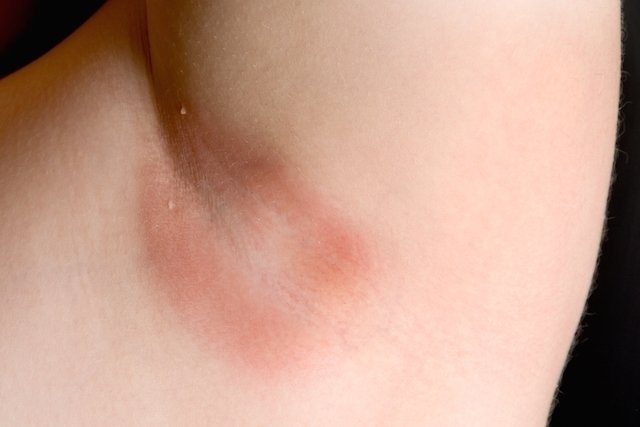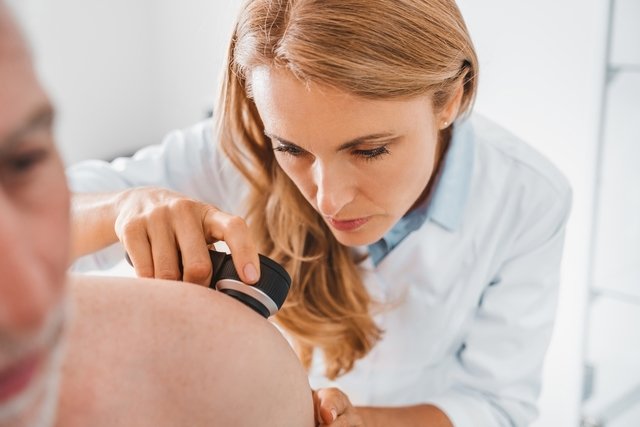Cutaneous candidiasis is a skin infection caused by the fungus Candida albicansoccurring mainly in the folds of the body, such as the neck, groin, armpits, behind the knee and under the breasts.
A C. albicans it can be found naturally on the skin, but it can proliferate and cause symptoms such as skin redness, itching, swelling and burning in the area.
Treatment for candidiasis on the skin must be guided by a dermatologist, who normally recommends the use of creams and ointments with antifungals that must be applied directly to the site of symptoms.
Sensitive content
This image may contain content that is uncomfortable for some people.

Main symptoms
The main symptoms of cutaneous candidiasis are:
- Itchy skin;
- Redness of the skin;
- Skin lesions with a well-defined border;
- Non-local burning;
- Small cracks in the skin, in some cases;
- Swelling at the site.
Symptoms of candidiasis on the skin are most common in the armpits, groin, neck, navel, behind the knee, between the fingers and under the breasts, as these are warmer and more humid areas, which favors the development of the fungus.
How the diagnosis is made
The diagnosis of cutaneous candidiasis is made by a dermatologist by observing the symptoms presented by the person. However, to confirm that the symptoms are caused by fungal growth Candida albicans on the skin, the doctor can take a scraping of the lesion so that it can be analyzed in the laboratory.
Taking care of your health has never been easier!
Causes of cutaneous candidiasis
Cutaneous candidiasis is caused by the fungus Candida albicans, which can be naturally found in the body without causing any signs or symptoms. However, due to some situations, it is possible to proliferate and cause the appearance of symptoms.
The main factors that can favor candidiasis on the skin are:
- Very hot and/or very humid climate;
- Use of clothing with synthetic fabric;
- Wearing very tight clothes;
- Frequent use of medications, such as antibiotics or corticosteroids;
- Decompensated diabetes;
- Thyroid changes;
- Psoriasis;
- Inadequate hygiene;
- Pregnancy
Cutaneous candidiasis can happen to anyone, however it is more common in people who are overweight, older people and children who wear diapers.
How the treatment is carried out
Treatment for cutaneous candidiasis must be carried out according to the dermatologist’s instructions, which normally recommends the use of antifungal creams or ointments, such as nystatin, clotrimazole, miconazole or ketoconazole, which must be applied directly to the red spots on the skin. This way, it is possible to combat excess fungi and promote symptom relief.
Furthermore, it is important to keep the fold areas always clean and dry, wear light clothing and cotton underwear and improve hygiene habits, especially in the area where the symptoms were noticed. This way, it is possible to prevent cutaneous candidiasis from recurring.
If cutaneous candidiasis occurs as a result of the use of medication or illness, it is important to consult a doctor so that an assessment can be made and the best treatment option can be discussed.
Bibliography
- PEIXOTO, Juliana V.; ROCHA, Mayara G.; NASCIMENTO, Rayssa Tuana L. et al. Brazilian Journal of Surgery and Clinical Research. Candidiasis – a literature review. Vol 8. 2 ed; 75 – 82, 2014

Sign up for our newsletter and stay up to date with exclusive news
that can transform your routine!
Warning: Undefined array key "title" in /home/storelat/public_html/wp-content/plugins/link-whisper-premium/templates/frontend/related-posts.php on line 12
Warning: Undefined array key "title_tag" in /home/storelat/public_html/wp-content/plugins/link-whisper-premium/templates/frontend/related-posts.php on line 13




